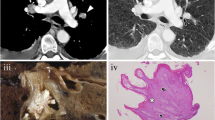Abstract
CT postprocessing allows more scan information to be viewed at one time allowing an accurate diagnosis to be made more efficiently, and is particularly important in paediatric practice where invasive clinical diagnostic tools can be replaced or at least assisted by modern postprocessing techniques. Four visualization techniques in clinical use are described in this paper including the advantages and disadvantages of each: multiplanar reformation, maximum and minimum intensity projections, shaded surface display and volume rendering. Volume-rendered internal visualization in the form of virtual endoscopy is also discussed. In addition, the clinical usefulness in paediatric practice of demonstrating airway compression and its causes are discussed. Advanced postprocessing techniques that must still find their way from the biomedical research environment into clinical use are introduced with specific reference to computer-aided diagnosis.






















Similar content being viewed by others
References
du Plessis J, Goussard P, Andronikou S et al (2009) Comparing three-dimensional volume-rendered CT images with fibreoptic tracheobronchoscopy in the evaluation of airway compression caused by tuberculous lymphadenopathy in children. Pediatr Radiol 39:694–702
Fishman EK, Ney DR, Heath DG et al (2006) Volume rendering versus maximum intensity projection in CT angiography: what works best, when, and why. Radiographics 26:905–922
Dalrymple NC, Prasad SR, Frecketon MW et al (2005) Informatics in radiology (infoRAD): introduction to the language of three-dimensional imaging with multidetector CT. Radiographics 25:1409–1428
Rubin GD (2003) 3-D imaging with MDCT. Eur J Radiol 45 (Suppl 1):S37–S41
Kirchgeorg MA, Prokop M (1998) Increasing spiral CT benefits with postprocessing applications. Eur J Radiol 28:39–54
Ueno J, Murase T, Yoneda K et al (2004) Three-dimensional imaging of thoracic diseases with multi-detector row CT. J Med Invest 51:163–170
Peloschek P, Sailer J, Weber M et al (2007) Pulmonary nodules: sensitivity of maximum intensity projection versus that of volume rendering of 3D multidetector CT data. Radiology 243:561–569
Papaioannou G, Young C, Owens CM (2007) Multidetector row CT for imaging the paediatric tracheobronchial tree. Paediatr Radiol 37:515–529
Perandini S, Feccioli N, Zaccarella A et al (2010) The diagnostic contribution of CT volumetric rendering techniques in routine practice. Indian J Radiol Imaging 20:92–97
Siegel M (2003) Multiplanar and three-dimensional multi-detector row CT of thoracic vessels and airways in the pediatric population. Radiology 229:641–650
Sodhi KS, Aiyappan SK, Saxena AK et al (2010) Utility of multidetector CT and virtual bronchoscopy in tracheobronchial obstruction in children. Acta Paediatr 99:1011–1015
Remy-Jardin M, Remy J, Artaud D et al (1998) Volume rendering of the tracheobronchial tree: clinical evaluation of bronchographic images. Radiology 208:761–770
Sonka M, Park W, Hoffman E (1996) Rule-based detection of intrathoracic airway trees. IEEE Trans Med Imaging 15:314–326
Mori K, Hasegawa J, Toriwaki J et al (1996) Recognition of bronchus in three-dimensional X-ray CT images with application to virtualized bronchoscopy system. In: Proceedings of the 13th International Conference on Pattern Recognition, vol 3. Vienna, Austria. IEEE Computer Society, Washington DC, pp 528–532
Tschirren J, Hoffman E, McLennan G et al (2005) Intrathoracic airway trees: segmentation and airway morphology analysis from low-dose CT scans. IEEE Trans Med Imaging 24:1529–1539
Fetita C, Preteux F, Beigelman-Aubry C et al (2004) Pulmonary airways: 3-D reconstruction from multislice CT and clinical investigation. IEEE Trans Med Imaging 23:1353–1364
Kiraly A, Higgins W, McLennan G et al (2002) Three-dimensional human airway segmentation methods for clinical virtual bronchoscopy. Acad Radiol 9:1153–1168
Irving B, Taylor P, Todd-Pokropek A (2009) 3D segmentation of the airway tree using a morphology based method. In: Brown M, de Bruijne M, van Ginneken B et al (eds) Proceedings of the second international workshop on pulmonary image analysis. London, pp 297–307
Lo P, van Ginneken B, Reinhardt J et al (2009) Extraction of airways from CT. In: Brown M, de Bruijne M, van Ginneken B et al (eds) Proceedings of the second international workshop on pulmonary image analysis. London, pp 175–189
Irving B, Goussard P, Gie R et al (2011) Segmentation of obstructed airway branches in CT using airway topology and statistical shape analysis. In: Proceedings of the eighth IEEE international symposium on biomedical imaging: from nano to macro. IEEE, Piscataway, NJ, pp 447–451
Vincent L (1993) Morphological grayscale reconstruction in image analysis: applications and efficient algorithms. IEEE Trans Image Process 2:176–201
Palágyi K, Tschirren J, Hoffman E et al (2006) Quantitative analysis of pulmonary airway tree structures. Comput Biol Med 36:974–996
Irving B, Goussard P, Gie R et al (2011) Identification of paediatric tuberculosis from airway shape features. Med Image Comput Comput Assist Interv 14:133–140
Tschirren J, McLennan G, Palágyi K et al (2005) Matching and anatomical labeling of human airway tree. IEEE Trans Med Imaging 24:1540–1547
Mori K, Hasegawa J, Suenaga Y et al (2000) Automated anatomical labeling of the bronchial branch and its application to the virtual bronchoscopy system. IEEE Trans Med Imaging 19:103–114
Kiraly A, Odry B, Godoy M et al (2008) Computer-aided diagnosis of the airways: beyond nodule detection. J Thorac Imaging 23:105
Author information
Authors and Affiliations
Corresponding author
Rights and permissions
About this article
Cite this article
Andronikou, S., Irving, B., Hlabangana, L.T. et al. Technical developments in postprocessing of paediatric airway imaging. Pediatr Radiol 43, 269–284 (2013). https://doi.org/10.1007/s00247-012-2468-1
Received:
Accepted:
Published:
Issue Date:
DOI: https://doi.org/10.1007/s00247-012-2468-1




